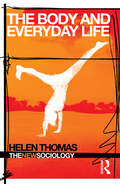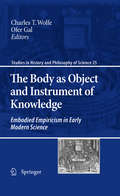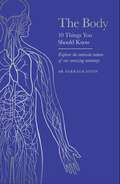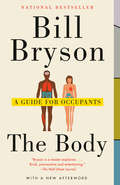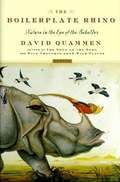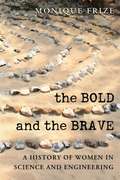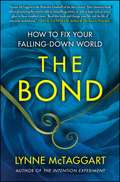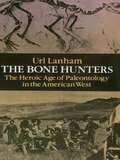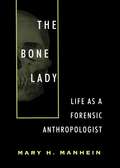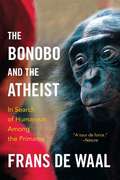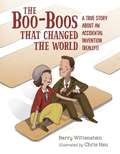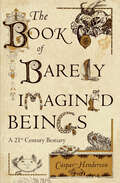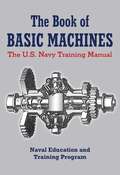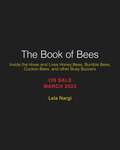- Table View
- List View
The Body and Everyday Life (The New Sociology)
by Helen ThomasIn recent years, there has been an explosion of interest in the contemporary social study of the body which has raised important theoretical and methodological questions regarding traditional social and cultural analysis. It has also generated corporeal theories that highlight the fluid, shifting, yet situated character of the body in society. In turn, these corporeal theories have implications for social relations in an era of new technologies and global market economies. The Body and Everyday Life offers a lively and comprehensive introduction to the study of the body. It uses case studies in performance practices to examine the key concepts, methods and critical insights gained from this area. It includes sections on: ethnographies of the body bodies of performance performing gender the ageing performing body. This book clearly illustrates the complex relationships that exist between the body, society and everyday life, and considers the negative and positive implications for the development of future socio-cultural analysis in the field. It will be an invaluable introduction for students of sociology, body studies, gender studies, dance and performance, and cultural studies.
The Body as Object and Instrument of Knowledge
by Ofer Gal Charles T. WolfeIt was in 1660s England, according to the received view, in the Royal Society of London, that science acquired the form of empirical enquiry we recognize as our own: an open, collaborative experimental practice, mediated by specially-designed instruments, supported by civil discourse, stressing accuracy and replicability. Guided by the philosophy of Francis Bacon, by Protestant ideas of this worldly benevolence, by gentlemanly codes of decorum and by a dominant interest in mechanics and the mechanical structure of the universe, the members of the Royal Society created a novel experimental practice that superseded former modes of empirical inquiry, from Aristotelian observations to alchemical experimentation. This volume focuses on the development of empiricism as an interest in the body - as both the object of research and the subject of experience. Re-embodying empiricism shifts the focus of interest to the 'life sciences'; medicine, physiology, natural history. In fact, many of the active members of the Royal Society were physicians, and a significant number of those, disciples of William Harvey and through him, inheritors of the empirical anatomy practices developed in Padua during the 16th century. Indeed, the primary research interests of the early Royal Society were concentrated on the body, human and animal, and its functions much more than on mechanics. Similarly, the Académie des Sciences directly contradicted its self-imposed mandate to investigate Nature in mechanistic fashion, devoting a significant portion of its Mémoires to questions concerning life, reproduction and monsters, consulting empirical botanists, apothecaries and chemists, and keeping closer to experience than to the Cartesian standards of well-founded knowledge. These highlighted empirical studies of the body, were central in a workshop in the beginning of 2009 organized by the unit for History and Philosophy of Science in Sydney. The papers that were presented by some of the leading figures in this area are presented in this volume.
The Body in Spinoza and Nietzsche
by Razvan IoanThis engaging volume sheds light on the central role the turn to the body plays in the philosophies of Spinoza and Nietzsche, providing an ideal starting point for understanding their work. Ioan explores their critiques of traditional morality, as well as their accounts of ethics, freedom and politics, arguing that we can best compare their respective philosophical physiologies, and their broader philosophical positions, through their shared interest in the notion of power. In spite of significant differences, Ioan shows the ways in which the two thinkers share remarkable similarities, delving into their emphatic appeal to the body as the key to solving fundamental philosophical problems, both theoretical and practical.
The Body: 10 Things You Should Know (10 Things You Should Know)
by Dr Darragh EnnisNeil Delamere: 'Smart, accessible and full of brilliant tidbits'Dave Moore: 'A delightful wander through the human body'Dylan Evans: 'Prepare to be genuinely astonished by the marvels of the human body.'Explore the intricate nature of our amazing anatomy...Scientist and 'Chaser' Dr Darragh Ennis reveals everything about the human body in ten informative, bite-sized essays. We all have questions about our body that we really should know the answers to, so discover why blood is red, how our body defends itself, why we sleep, how hormones control everything we do and much, much more!A fascinating, illuminating and engaging read, it's the perfect gift for anyone interested in biology, DNA or who just wants to learn more about the human body.
The Body: 10 Things You Should Know (10 Things You Should Know)
by Dr Darragh EnnisNeil Delamere: 'Smart, accessible and full of brilliant tidbits'Dave Moore: 'A delightful wander through the human body'Dylan Evans: 'Prepare to be genuinely astonished by the marvels of the human body.'Explore the intricate nature of our amazing anatomy...Scientist and 'Chaser' Dr Darragh Ennis reveals everything about the human body in ten informative, bite-sized essays. We all have questions about our body that we really should know the answers to, so discover why blood is red, how our body defends itself, why we sleep, how hormones control everything we do and much, much more!A fascinating, illuminating and engaging read, it's the perfect gift for anyone interested in biology, DNA or who just wants to learn more about the human body.
The Body: 10 Things You Should Know (10 Things You Should Know)
by Dr Darragh EnnisNeil Delamere: 'Smart, accessible and full of brilliant tidbits'Dave Moore: 'A delightful wander through the human body'Dylan Evans: 'Prepare to be genuinely astonished by the marvels of the human body.'Explore the intricate nature of our amazing anatomy...Scientist and 'Chaser' Dr Darragh Ennis reveals everything about the human body in ten informative, bite-sized essays. We all have questions about our body that we really should know the answers to, so discover why blood is red, how our body defends itself, why we sleep, how hormones control everything we do and much, much more!A fascinating, illuminating and engaging read, it's the perfect gift for anyone interested in biology, DNA or who just wants to learn more about the human body.
The Body: A Guide for Occupants
by Bill BrysonBill Bryson, bestselling author of A Short History of Nearly Everything, takes us on a head-to-toe tour of the marvel that is the human body. As compulsively readable as it is comprehensive, this is Bryson at his very best, a must-read owner's manual for everybody.Bill Bryson once again proves himself to be an incomparable companion as he guides us through the human body--how it functions, its remarkable ability to heal itself, and (unfortunately) the ways it can fail. Full of extraordinary facts (your body made a million red blood cells since you started reading this) and irresistible Bryson-esque anecdotes, The Body will lead you to a deeper understanding of the miracle that is life in general and you, in particular. As Bill Bryson writes, "we pass our existence within this wobble of flesh and yet take it almost entirely for granted." The Body will cure that indifference with generous doses of wondrous, compulsively readable facts and information.
The Body: A Guide for Occupants
by Bill BrysonNEW YORK TIMES BESTSELLER • A must-read owner&’s manual for every body. Take a head-to-toe tour of the marvel that is the human body in this &“delightful, anecdote-propelled read&” (The Boston Globe) from the author of A Short History of Nearly Everything. With a new Afterword. &“You will marvel at the brilliance and vast weirdness of your design." —The Washington Post Bill Bryson once again proves himself to be an incomparable companion as he guides us through the human body—how it functions, its remarkable ability to heal itself, and (unfortunately) the ways it can fail. Full of extraordinary facts (your body made a million red blood cells since you started reading this) and irresistible Brysonesque anecdotes, The Body will lead you to a deeper understanding of the miracle that is life in general and you in particular. As Bill Bryson writes, &“We pass our existence within this wobble of flesh and yet take it almost entirely for granted.&” The Body will cure that indifference with generous doses of wondrous, compulsively readable facts and information. As addictive as it is comprehensive, this is Bryson at his very best.
The Boilerplate Rhino: Nature in the Eye of the Beholder
by David QuammenThe author hailed by Edward O. Wilson as "a brilliant young star of nature writing" explores the relationship between humans and the natural world in a collection of essays culled from his popular "Outside" magazine column.
The Bold and the Brave: A History of Women in Science and Engineering
by Monique FrizeThe Bold and the Brave investigates how women have striven throughout history to gain access to education and careers in science and engineering. Author Monique Frize, herself an engineer for over 40 years, introduces the reader to key concepts and debates that contextualize the obstacles women have faced and continue to face in the fields of science and engineering. She focuses on the history of women’s education in mathematics and science through the ages, from antiquity to the Enlightenment. While opportunities for women were often purposely limited, she reveals how many women found ways to explore science outside of formal education. The book examines the lives and work of three women –Sophie Germain, Mileva Einstein, and Rosalind Franklin – that provide excellent examples of how women’s contributions to science have been dismissed, ignored or stolen outright. She concludes with an in-depth look at women’s participation in science and engineering throughout the twentieth century and the current status of women in science and engineering, which has experienced a decline in recent years. To encourage more young women to pursue careers in science and engineering she advocates re-gendering the fields by integrating feminine and masculine approaches that would ultimately improve scientific and engineering endeavours.
The Boletes of China: Tylopilus s.l.
by Yan-Chun Li Zhu L. YangThis book introduces the Chinese boletes, including the history, ecological and economic values, as well as the geographical distribution patterns with a highlight on the Tylopilus species. Species in Tylopilus s.l. are not only of important ecological values but also of scientific interests. They are very diverse in morphology, complex in structure and wide in ecological niches. China is one of the diverse hotspots of boletes, and many boletes were traditionally treated as members of Tylopilus based on hymenophore or spore-print colour. The studies revealed that the traditionally defined Tylopilus is polyphyletic. This book aims to elucidate the phylogenetic relationships among the genera treated in Tylopilus s.l. previously; to delimit and recognize the taxa, and finally to reveal the diversity of the genera and species of Tylopilus s.l. in China. The book is intended to be a reference for biologists who conduct investigations of biological resources and biodiversity; university and college teachers and students carrying out studies in related fields; mycologists and amateur mycologists, or people who interested in mushrooms taxonomy and systematics; and workers in the development of non-timber forest products.
The Bomb Doctor: A Scientist's Story of Bombers, Beakers, and Bloodhounds
by Selene Yeager Kirk YeagerA rare peek behind the curtain into boots-on-the-ground, in-the-lab scientific bomb forensics—told with humanity, heart, and even a bit of humor.This is not CSI. What you encounter as a true bomb detective—or &“Bomb Doctor,&” as some in the FBI call me—are fields of twisted metal containing soot-covered fragments intermingled with human remains. You have carnage and chaos. As you wade into that sea of wailing sirens and screaming survivors awash with the stench of diesel fuel and decaying bodies, your job is to ferret out forensic clues in a type of macabre scavenger hunt to ultimately reconstruct the scene and the explosive device and determine what happened and what the bomb looked like before it was torn asunder. None of this happens overnight. Nor does it happen in a timeframe that can be neatly packaged in an hour-long made-for-TV drama. The scavenger hunt can take months—or, in the case of the infamous Collar Bomber, seven painstaking years. The work is worth every second and every horrific image that etches itself into your brain because it helps prevent new horrors. Not all, obviously. We are not superheroes. But unlike shooters, who often just &“snap&” or seem to act out in random ways, bombers almost always have a story—one that follows an arc. In The Bomb Doctor, my goal is to explain that arc, explode myths, reconstruct reality, and build an understanding of the reason and means behind the mayhem, as well as pull back the curtain on the investigative process that brings bombers to justice.
The Bomb in My Garden: The Secrets of Saddam's Nuclear Mastermind
by Mahdi Obeidi Kurt PitzerObeidi, the former director-general of Iraq's Ministry of Industry and Military Industrialization under Saddam Hussein, was involved in Iraq's quest for a nuclear bomb beginning in the late 1970s. In this memoir, he tells his story of his work in the program, describing how the efforts came to a halt after the first Gulf War, and how he watched as the U. S. used allegations he knew were false to justify the invasion of his country. In many parts, the story is as much personal as professional as he worries about the fate of his family in difficult times.
The Bomb: A New History
by Steven M. YoungerA former Los Alamos weapons designer shares “an indispensable guide to the science and strategy of nuclear weapons” (Booklist).From his years at Los Alamos and the Nevada Test Site to his meetings with nuclear arms experts in Moscow, former weapons designer Stephen M. Younger has witnessed firsthand the making of nuclear policy. With a deep understanding of both the technology and the politics behind nuclear weapons, he guides us from the Manhattan Project to the Cold War and into the present day, illuminating how nuclear weapons fit into our globalized, war-plagued world. With startling clarity, Younger reveals how weapons work, the myths and realities of what happens after a nuclear explosion, and how our nuclear policy evolved to what it is today. In an era when rogue nations like North Korean and Iran strive to create their own precarious weapons programs, Younger provides much-needed background and insight for students, policy makers, and readers who wish to better understand the important issues involving nuclear weapons and national security.“Younger has provided an insightful guide, especially for the general reader, into today’s array of nuclear powers and their capabilities.” —James Schlesinger, former Secretary of Defense and Secretary of Energy
The Bond: How to Fix Your Falling-Down World
by Lynne McTaggartFor centuries, Western science and many Western cultures have taught us to think of ourselves as individuals. But today, a revolutionary new understanding is emerging from the laboratories of the most cutting-edge physicists, biologists, and psychologists: What matters is not the isolated entity, but the space between things, the relationship of things. The Bond. By international bestselling author Lynne McTaggart, The Bond is the culmination of her groundbreaking work. It offers a completely new, scientific story of life and the human experience, one that challenges the very way we conceive of ourselves and our world. The Bond shows that the essential impulse of all life is a will to connect rather than a drive to compete. In fact, we are inescapably connected, hardwired to each other at our most elemental level—from cells to whole societies. The desire to help others is so necessary that we experience it as one of our chief pleasures, as essential as eating and having sex, and we succeed and prosper only when we see ourselves as part of a greater whole. Every conflict that occurs—whether between husband and wife, social or racial groups, or nations—is resolved only when we can fully see and embrace the space—the bond—between us. McTaggart offers detailed recommendations to help foster more holistic thinking, more cooperative relationships, and more unified social groups. Blending interviews and human stories into an absorbing narrative, she shows how: • A simple daily practice conditions the brain to enable you to become more empathetic toward others • A new way of speaking and listening can overcome polarization, helping the staunchest of enemies to become close friends • People who fire together wire together: Whenever a group works together for a common goal, the brains of all parties begin to get on the same wavelength, strengthening the bond within the group • Fairness is more powerful than unfairness: A small group of individuals committed to strong reciprocity can “invade” a population of self-interested individuals and create a fairer society The Bond offers a breathtaking, visionary plan for a new way to live, in harmony with our true nature and with each other, and a new way to heal our relationships, our neighborhoods, and our world.
The Bone Detectives: How Forensic Anthropologists Solve Crimes and Uncover Mysteries of the Dead
by Donna M. Jackson Charlie FellenbaumIt's said that "dead men tell no tales" -- yet their bones have some interesting stories to reveal. That's what police depend on when the only clues to a crime are the bones of the victim. Then it's time to call in the "bone detectives". Following forensic anthropologist Dr. Michael Charney step-by-step through an investigation, this book shows how a person's sex, race, age, height, and weight can be determined from studying his or her bones and teeth; how markings on bones can be "read" to establish cause of death; how a sculptor uses clay to reconstruct a face from a skull so it can be publicized in the media and possibly recognized; and how all of this information can be used to help crack a case. Curious young readers will revel in every eerie detail of award-winning journalist Donna Jackson's lively text and Charlie Fellenbaum's full-color photographs as they discover how these fascinating detectives help the stories behind the bones come to life.
The Bone Hunters: The Heroic Age of Paleontology in the American West
by Url Lanham"Highly recommended to all scientists and non-scientists interested in paleontology and the West." -- Science Books A century after the founding of the Republic, the United States was a leader in the science of vertebrate paleontology -- the study of the fossils of backboned animals. In this lucid, nontechnical study, a noted popularizer of science and former curator at the Museum of the University of Colorado first reviews the geology of the western United States and provides an overview of American paleontology since the days of Thomas Jefferson.Dr. Lanham next focuses on the paleontologists themselves and the astounding fossil discoveries that revolutionized our understanding of vertebrate evolution. You'll learn how nineteenth-century paleontologists struggled against hostile Indians, scorching summers and frigid winters, loneliness, isolation, lack of funds and other hardships as they excavated tons of fossil bones from beds and quarries in South Dakota, Kansas, Wyoming, Utah, Colorado, and other areas. While many eminent scientists are profiled, including Samuel Williston, John Bell Hatcher, Ferdinand Vandiveer Hayden, and Joseph Leidy, much of the book is devoted to the explorations and achievements of Othniel Charles Marsh and Edward Drinker Cope. These two brilliant paleontologists, whose discoveries revolutionized the discipline, eventually became bitter rivals and the central figures in one of the most notorious scientific feuds of the century.These and many other aspects of nineteenth-century paleontology are covered in this fascinating and readable book. Easily accessible to the layman, The Bone Hunters will appeal to any reader interested in the behind-the-scenes drama and inspired scientific fieldwork that resulted in an explosion of knowledge about the nature and evolution of the prehistoric animals that once roamed the American West.
The Bone Lady: Life as a Forensic Anthropologist
by Mary H. ManheinAs director of the Forensic Anthropology and Computer Enhancement Services (FACES) Laboratory at Louisiana State University, Manhein unravels mysteries of life and death every day. In "The Bone Lady", she shares many fascinating cases that include the science underlying her analyses as well as the human stories behind the remains.
The Bonobo And The Atheist: In Search Of Humanism Among The Primates
by Frans De WaalFor many years, de Waal has observed chimpanzees soothe distressed neighbors and bonobos share their food. Now he delivers fascinating fresh evidence for the seeds of ethical behavior in primate societies that further cements the case for the biological origins of human fairness. Interweaving vivid tales from the animal kingdom with thoughtful philosophical analysis, de Waal seeks a bottom-up explanation of morality that emphasizes our connection with animals. In doing so, de Waal explores for the first time the implications of his work for our understanding of modern religion. Whatever the role of religious moral imperatives, he sees it as a "Johnny-come-lately" role that emerged only as an addition to our natural instincts for cooperation and empathy. But unlike the dogmatic neo-atheist of his book's title, de Waal does not scorn religion per se. Instead, he draws on the long tradition of humanism exemplified by the painter Hieronymus Bosch and asks reflective readers to consider these issues from a positive perspective: What role, if any, does religion play for a well-functioning society today? And where can believers and nonbelievers alike find the inspiration to lead a good life?Rich with cultural references and anecdotes of primate behavior, The Bonobo and the Atheist engagingly builds a unique argument grounded in evolutionary biology and moral philosophy. Ever a pioneering thinker, de Waal delivers a heartening and inclusive new perspective on human nature and our struggle to find purpose in our lives.
The Bonobo and the Atheist: In Search of Humanism Among the Primates
by Frans De WaalIn this lively and illuminating discussion of his landmark research, esteemed primatologist Frans de Waal argues that human morality is not imposed from above but instead comes from within. Moral behavior does not begin and end with religion but is in fact a product of evolution. For many years, de Waal has observed chimpanzees soothe distressed neighbors and bonobos share their food. Now he delivers fascinating fresh evidence for the seeds of ethical behavior in primate societies that further cements the case for the biological origins of human fairness. Interweaving vivid tales from the animal kingdom with thoughtful philosophical analysis, de Waal seeks a bottom-up explanation of morality that emphasizes our connection with animals. In doing so, de Waal explores for the first time the implications of his work for our understanding of modern religion. Whatever the role of religious moral imperatives, he sees it as a "Johnny-come-lately" role that emerged only as an addition to our natural instincts for cooperation and empathy. But unlike the dogmatic neo-atheist of his book's title, de Waal does not scorn religion per se. Instead, he draws on the long tradition of humanism exemplified by the painter Hieronymus Bosch and asks reflective readers to consider these issues from a positive perspective: What role, if any, does religion play for a well-functioning society today? And where can believers and nonbelievers alike find the inspiration to lead a good life? Rich with cultural references and anecdotes of primate behavior, The Bonobo and the Atheist engagingly builds a unique argument grounded in evolutionary biology and moral philosophy. Ever a pioneering thinker, de Waal delivers a heartening and inclusive new perspective on human nature and our struggle to find purpose in our lives.
The Boo-Boos That Changed the World: A True Story About An Accidental Invention (really!)
by Barry WittensteinThe true story of Earl Dickson inventing Band Aid for his injury prone wife, Josephine.
The Book That Changed America: How Darwin's Theory of Evolution Ignited a Nation
by Randall FullerA compelling portrait of a unique moment in American history when the ideas of Charles Darwin reshaped American notions about nature, religion, science and race“A lively and informative history.” – The New York Times Book ReviewThroughout its history America has been torn in two by debates over ideals and beliefs. Randall Fuller takes us back to one of those turning points, in 1860, with the story of the influence of Charles Darwin’s just-published On the Origin of Species on five American intellectuals, including Bronson Alcott, Henry David Thoreau, the child welfare reformer Charles Loring Brace, and the abolitionist Franklin Sanborn. Each of these figures seized on the book’s assertion of a common ancestry for all creatures as a powerful argument against slavery, one that helped provide scientific credibility to the cause of abolition. Darwin’s depiction of constant struggle and endless competition described America on the brink of civil war. But some had difficulty aligning the new theory to their religious convictions and their faith in a higher power. Thoreau, perhaps the most profoundly affected all, absorbed Darwin’s views into his mysterious final work on species migration and the interconnectedness of all living things. Creating a rich tableau of nineteenth-century American intellectual culture, as well as providing a fascinating biography of perhaps the single most important idea of that time, The Book That Changed America is also an account of issues and concerns still with us today, including racism and the enduring conflict between science and religion.
The Book of Barely Imagined Beings: A 21st Century Bestiary
by Caspar Henderson“Caspar Henderson takes us on an eye-opening tour of real animals that no sane human could ever have invented.” —Frans de Waal, New York Times–bestselling authorWith The Book of Barely Imagined Beings, Caspar Henderson offers readers a fascinating, beautifully produced modern-day menagerie. But whereas medieval bestiaries were often based on folklore and myth, the creatures that abound in Henderson’s book—from the axolotl to the zebrafish—are, with one exception, very much with us, albeit sometimes in depleted numbers. The Book of Barely Imagined Beings transports readers to a world of real creatures that seem as if they should be made up—that are somehow more astonishing than anything we might have imagined. The yeti crab, for example, uses its furry claws to farm the bacteria on which it feeds. The waterbear, meanwhile, is among nature’s “extreme survivors,” able to withstand a week unprotected in outer space. These and other strange and surprising species invite readers to reflect on what we value—or fail to value—and what we might change.A powerful combination of wit, cutting-edge natural history, and philosophical meditation, The Book of Barely Imagined Beings is an infectious and inspiring celebration of the sheer ingenuity and variety of life in a time of crisis and change.“The Book of Barely Imagined Beings is one that Pliny would have envied, Darwin applauded, and Borges relished . . . In these days of doom and gloom, I can think of nothing more rejoicing than Caspar Henderson’s magical book.” —Alberto Manguel, author of A History of Reading“Magnificent, bravura, beautiful and astoundingly interesting.” —The Sunday Times“Spell-binding, brilliantly executed, extraordinary.” —The Guardian
The Book of Basic Machines: The U.S. Navy Training Manual
by U. S. NavyHave you ever wondered why levers and pulleys make it easy to lift heavy objects? Or thought about what it is that makes a combustion engine work?The Book of Basic Machines will give you the information you need to understand key concepts, techniques, components, and much more. Designed and prepared by the Naval Education and Training Program Development Center for naval training, and taught widely in technical school across the country, the manual covers the theory and application of many of the most important mechanical ideas. Concepts build effortlessly from one chapter to the next. Clear explanations, illuminating examples, and over 200 skillfully rendered diagrams, cross-sections, and illustrations make it remarkably easy for readers of any level to understand the fascinating inner-workings of basic machines. The Book of Basic Machines is an invaluable resource for mechanical engineering students looking to learn the basics, working engineers wanting to brush up on some theory, or hobbyists who simply want to know how things work. Simply put, this book is required reading for anyone interested in machines. From the basics of simple levers to the principles of the internal combustion engine, The Book of Basic Machines covers every aspect of basic machinery.
The Book of Bees: Inside the Hives and Lives of Honeybees, Bumblebees, Cuckoo Bees, and Other Busy Buzzers
by Lela NargiFilled with more than 150 beautiful, crystal-clear photos and bee fun facts, The Book of Bees is the ultimate guide for kids to explore the lives of these stunning insects and learn about their critical role in fostering a sustainable, healthy Earth.Did you know there are blue bees and green bees? Or that one species of bee nests in snail shells? Or that many bees don&’t live in hives? With more than 20,000 species of bees worldwide, there&’s more to bees than just honey! The Book of Bees gives curious kids a close-up view of busy buzzers from around the world. From the familiar Western honeybee to the extra-large Himalayan giant honeybee and Australia&’s vibrant neon cuckoo bee, these pages are packed with detailed photos and fascinating facts on more than 50 species of bees. In-depth species profiles help you identify bees, learn about bee-havior, and find your favorites! And special features examine topics like hive life, nest cells, and other pollinators. The world of bees is exciting and surprising—and The Book of Bees will leave you buzzing!
